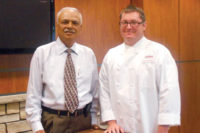Custom(er) Showplace












The Swiss company ended 2008 by re-organizing its former Nestlé Foodservices North America unit into Nestlé Professional, a worldwide business with 15 dedicated plants and global technology R&D centers in Orbe, Switzerland, (beverages) and Solon, Ohio, (food). In turn, the company announced plans to build a 67,000-sq-ft Nestlé Professional Customer Innovation Campus (NPCIC) in Solon, just outside Cleveland.
Opened exactly four years ago, NPCIC now is home to more than 100 associates, including as many as 20 chefs, food technologists, product developers and nutritionists. Still more associates handle everything from sales and marketing to operations and supply-chain management.
Nestlé Professional says it coordinates those functions for branded solutions that are “creative, customized and commercially viable” for operators in every foodservice channel. Business officials can leverage a large portfolio of branded entrées and sides (Stouffer’s, Lean Cuisine, Chef-mate); bases, sauces, gravies and chef specialties (Minor’s, Trio, Maggi, Chef-mate); stuffed sandwiches and snacks (Hot Pockets, Lean Pockets); and desserts and dessert ingredients (Nestlé Toll House, Libby, Carnation).
Never mind brand names and numbers. Kim Lehouiller, director of branded business development, notes that—in contrast to the “too many cooks” scenario—Nestlé Professional knows that only one person can be the principal decision-maker: the customer.
Lehouiller says Nestlé Professional customers work closely with operators to understand their operational needs, staff requirements, and operational motivations and preferences. Then, it’s off to the true work space: the kitchen.
“Our facility features an ‘operations’ kitchen, which allows us to directly simulate any customer’s equipment and set-up,” says Lehouiller. “Most of the equipment in this kitchen is on wheels, so it can be moved. We also use the kitchen to train brokers and customers with hands-on applications.”
According to Lehouiller, NPCIC also has a presentation kitchen—similar to something on television’s Food Network—complete with a large marble countertop for product demonstrations, trainings and after-hours customer receptions. It includes a wood-burning pizza oven and commercial woks. It also has griddles, ovens, stovetops, a fryer, tilt kettle, and even grills and a smoker outside on an adjacent patio.
“We want customers to work in the NPCIC kitchens the same way they do in their own operations,” notes Lehouiller, “…By housing all culinary functions together, products and product applications can be developed from concept through completion, so operators leave with solutions they can use right away.”
Understandably, officials cannot talk about their customers’ new product solutions. Meanwhile, however, there are more public “wins” that Nestlé Professional can share. These include gluten-free bases; whole-grain macaroni-and-cheese; and reduced- and low-sodium bases, sauces and entrees. Among the more noteworthy introductions is a nutrient-dense, easy-to-use soup for senior care and hospital feeders.
Restaurant operators also honored Stouffer’s Parmesan Risotto with one of the National Restaurant Association’s (NRA) 2012 Food and Beverage Product Innovations Awards. In this case, NRA asked independent judges to critique new offerings and rank those that “deliver significant restaurant operator benefits ranging from new flavor concepts to better-for-you nutritional profiles and operator flexibility.”
“Our esteemed panel of judges selected ground-breaking food and beverage products that customers will soon be buzzing about,” noted Jack Crawford, NRA convention chair and president and CEO of Ground Round Independent Owners Cooperative LLC. “These customer-centric standouts will give NRA show attendees plenty to think about and act on while they tour this year’s exhibit floor.”
Vid Lutz is an executive chef for Nestlé Professional.
“We looked at food and flavor menu trends from various sources and recognized that risotto is one of the top 10 fastest growing sides/ingredients in U.S. restaurants, with a growth rate of 52%,” he says. “Yet menu penetration is low, due to the preparation complexity and skill levels required in the back of the house. We surveyed more than 350 operators and uncovered the ‘unmet need’ for an authentic risotto that can be further customized by operators and improve speed of service.”
Lutz says Nestlé chefs, food scientists and product developers formulated Stouffer’s Parmesan risotto with 100% Arborio rice (the traditional base) along with real Parmesan cheese, chicken broth, onions, cream, butter, extra virgin olive oil, Asiago cheese and garlic. In turn, Lutz says Nestlé Professional also created a custom process to ensure a homogenous texture, “where the stock is cooked into the rice, thus capturing the starch from the rice.”
Nestlé Professional also tested the new offering with more than 55 operators before its introduction. Today, Nestlé distributes the product to full-service restaurant and lodging customers.
Meanwhile, senior living, long-term care and hospital feeders were targets for Nestlé Professional’s new Trio line of nutrient-dense soups, says Erin Gilgan, Nestlé Professional’s nutrition health and wellness manager.
“Key dietary concerns with this group are malnutrition, weight loss, lack of appetite, difficulty chewing/eating (due to dementia, Alzheimer’s), loss of muscle mass, strength and retention, reduced bone health, vision, immunity and low energy,” says Gilgan. “Our challenge was to find the appropriate balance between a savory, craveable and flavorful comfort food and one with the right nutrient content. A significant obstacle was to achieve an excellent source of calcium in a broth-based soup without making it cloudy or chalky.”
Gilgan credits product development technologist Raffaella Saggin and R&D nutrition scientist Kim Krumhar with creating six protein-rich soups with other essential nutrients. Officials say the soups incorporate milk powder, pea protein, whey protein, corn fiber and sunflower oil to deliver a balance of essential amino acids, heart-healthy fats and extra calcium.
Moreover, Gilgan says the soups have been a success since their July 2012 introduction.
“We achieved our nutrient density with fortification so that we could uphold each soup’s visual appearance, flavor and texture,” she says. “At the end of the day, we wanted easily digestible soups retaining all the familiar ingredients and flavors. The objective was to achieve nutrient density with ‘real ingredients’ first.”
Major Growth for Minor’s
Make no mistake. Minor’s is a major brand and business for Nestlé Professional. In fact, last year saw Nestlé celebrate Minor’s 60th anniversary and announce a multi-million dollar, 75,000-sq-ft addition to Minor’s Cleveland, Ohio, plant.
Minor’s traces its roots to 1951, when Dr. L. J. Minor, a food scientist, created a bouillon powder for the U.S. Army. From there, Minor began the Cleveland–based L.J. Minor Company with $6,000 and a borrowed mixer. Today, officials say Minor’s processes and supplies more than 140 different types of bases, “mother” sauces, premium sauces and gravies, ready-to-use sauces, flavor concentrates and chef specialties. It distributes to foodservice operators, brokers and industrial food-processing customers.
“This investment in our Minor’s Cleveland manufacturing plant demonstrates Nestlé’s commitment to the city of Cleveland,” said Perry Miele, president for Nestlé Professional, North America-Food. “Minor’s has been and will continue to be devoted to the Cleveland community and [is] a critical part of Nestlé Professional’s portfolio of premium brands and success.”
Nestlé expects to complete the Minor’s expansion by next summer (mid-2013). Officials have not said more about the project—other than to note that it will include “new advanced technologies and processes.” For the record, some of its most recent product offerings include all-natural bases and frozen mother sauces.
Then again, still more offerings are popular, as well.
“We developed natural chicken, beef and vegetable bases back in 2008, without the gluten-free claim,” notes Juerg Wismer, executive chef for Minor’s. “Since then, the need for gluten-free products has been growing exponentially, and in 2012, we began testing for gluten and can now make the gluten-free claim.”
Wismer says Minor’s is equally committed to back-of-the-house quality and convenience.
“We developed high-quality Beef Demi-glace and Hollandaise sauces, which meet the need for an operator to have a scratch-quality sauce in a convenient format and package,” says Wismer.… “[T]hese sauces are designed to be embellished by the operator. A chef can make the sauce his or her own by adding a red wine reduction and some butter to the Beef Demi-glace for a Burgundy sauce, or some tarragon and white wine vinegar to the Hollandaise for an authentic béarnaise:
A perfect complement to a filet mignon.”
Looking for a reprint of this article?
From high-res PDFs to custom plaques, order your copy today!












